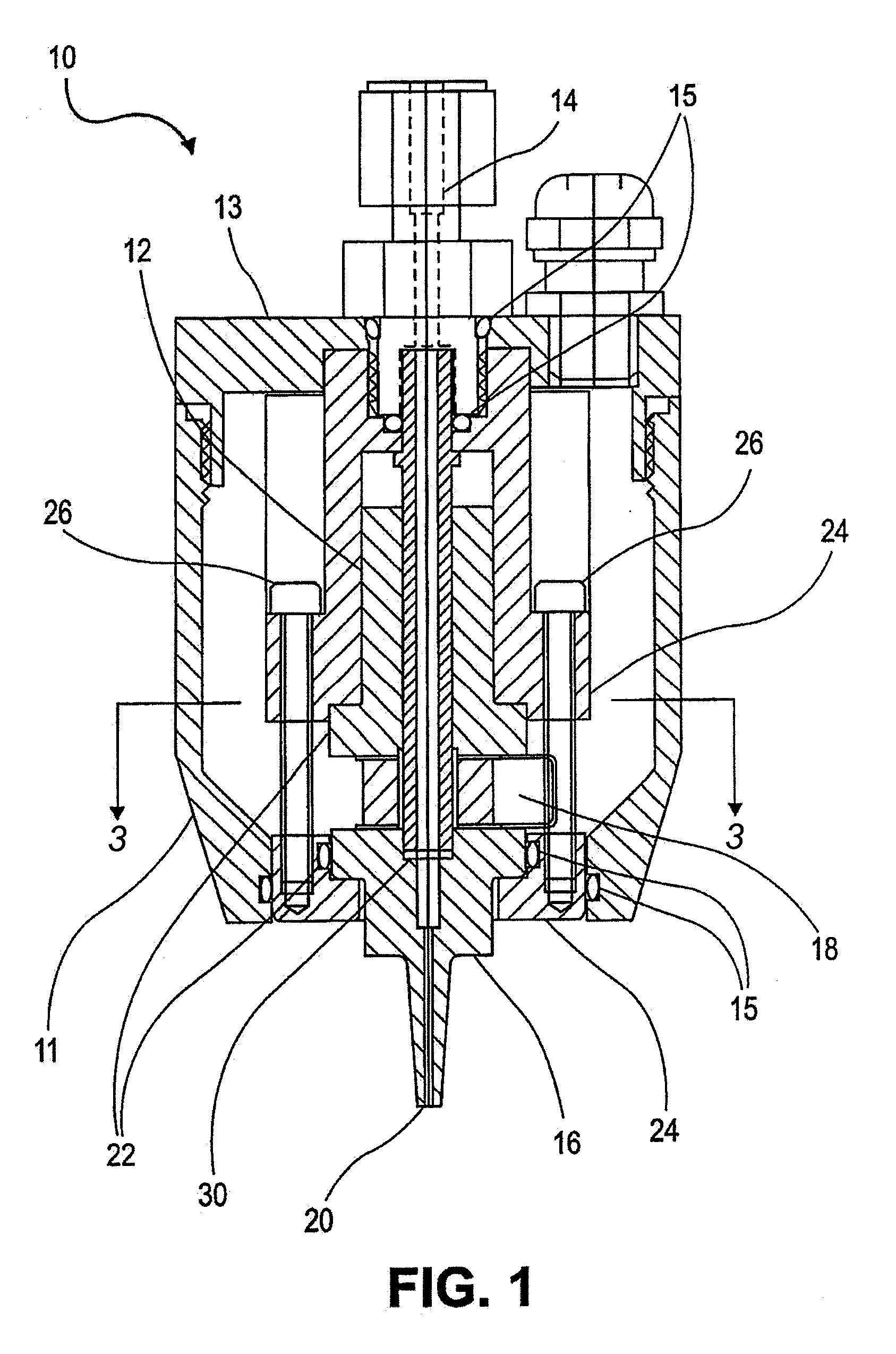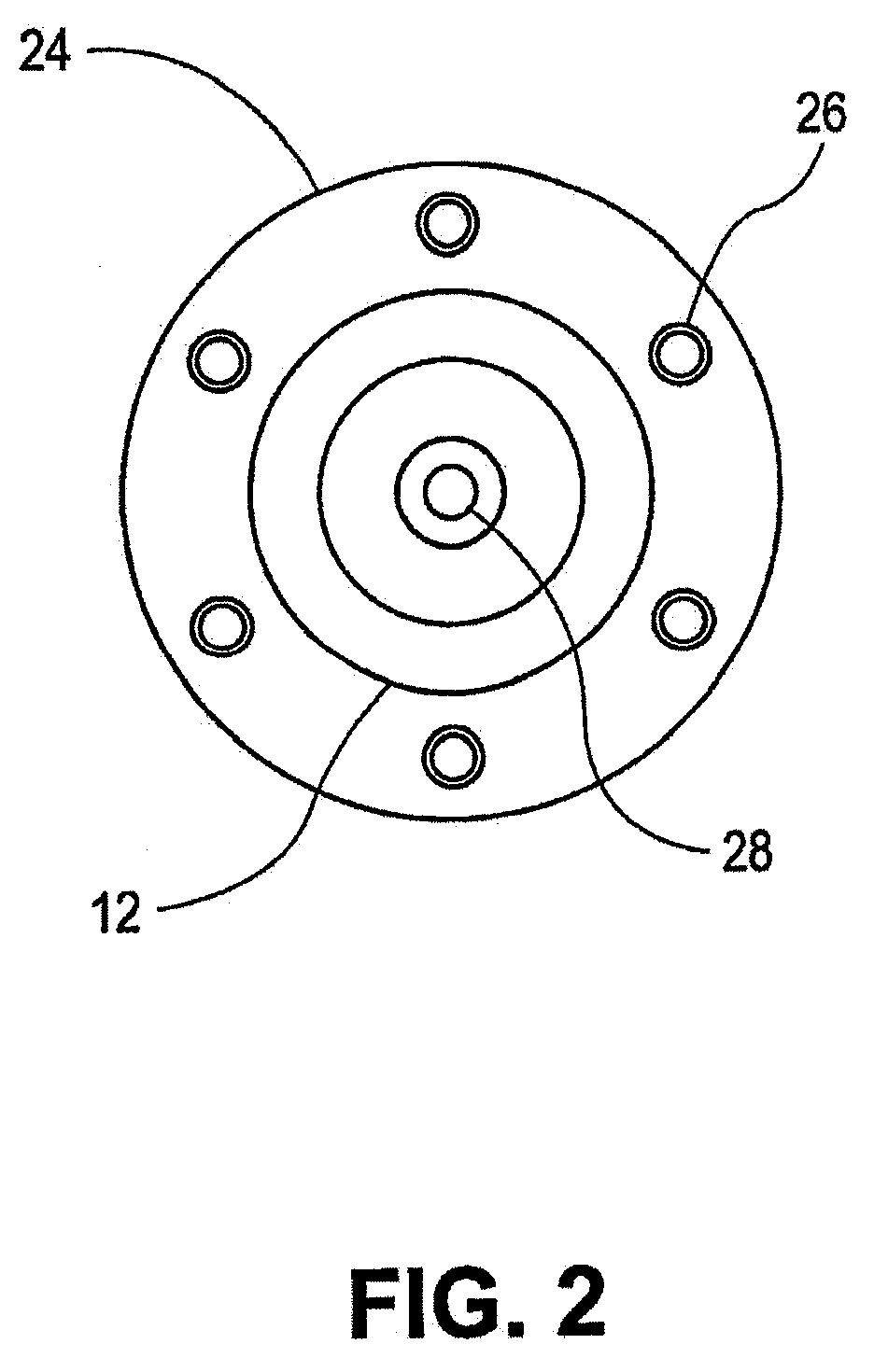Ultrasonic atomizing nozzle methods for the food industry
- Summary
- Abstract
- Description
- Claims
- Application Information
AI Technical Summary
Benefits of technology
Problems solved by technology
Method used
Image
Examples
first embodiment
[0020]The invention will now be described with reference to the drawing figures, in which like reference numerals refer to like parts throughout. FIG. 1 is a longitudinal cross-sectional view of a ceramic-containing ultrasonic atomizing nozzle arrangement 10 according to the present invention. However, before further discussing the drawing figures any further, a few scientific principles related to ultrasonic atomization are briefly reviewed below.
[0021]Ceramic materials (e.g., SiC and Al2O3) differ from metals (e.g., titanium and titanium alloys) in a number of ways. For example, in some ceramic materials, such as silicon carbide (SiC) and aluminum oxide (Al2O3), the characteristic velocity at which sound waves propagate through these materials is considerably greater than the characteristic velocity at which sound waves propagate through any metallic material that is practical for use in constructing an ultrasonic atomizing nozzle. For example, SiC can be manufactured such that th...
second embodiment
[0040]FIG. 3 is a longitudinal cross-sectional view of an ultrasonic atomizing nozzle arrangement 32 according to the present invention. Like the nozzle 10 illustrated in FIG. 1, the nozzle 32 illustrated in FIG. 3 includes a liquid inlet 34, a rear horn 36 and a front horn 38, each having a flange 40. The front horn 38 also includes an atomizing surface 42 that is positioned at one end of a liquid conduit 44. In addition, the nozzle 32 illustrated in FIG. 3 includes a clamp arrangement that includes a plurality of rings 46 and bolts 48. Further, the nozzle 32 also includes a transducer portion 49 that includes a pair of transducers that are positioned in an intermediate section of the nozzle 32 that is located between the rear horn 36 and the front horn 38. Also illustrated in FIG. 3 are a front shroud 33 and a rear shroud 35 that, together, provide a housing for the nozzle 32 and a plurality of O-rings 37 that provide a plurality of seals within this housing.
[0041]One way in which...
third embodiment
[0042]FIG. 4 and FIG. 5 illustrate a controllable ultrasonic sprayer 80 according to the present invention. A flat jet air deflector horn 82 is positioned adjacent to an atomizing surface 89 of an ultrasonic nozzle 85. The flat jet air deflector horn 82 and atomizing surface 89 are each located on a jet block assembly 87. The ultrasonic nozzle 85 may be made from titanium and 316 stainless steel making it non-reactive with most liquids, although other types of materials may also be used. An air inlet fitting 81 and a liquid inlet fitting 83 are also situated on jet block assembly 87.
[0043]In operation, a controllable source of air is attached to air inlet fitting 81 and liquid to be atomized is connected to the liquid inlet fitting 83. A controllable air stream 84 from the air inlet fitting 81 is sent towards the flat jet air deflector horn 82, which reshapes the controllable air stream 84 into a flattened air pattern 86. The flattened air is deflected toward the atomizing surface 8...
PUM
 Login to View More
Login to View More Abstract
Description
Claims
Application Information
 Login to View More
Login to View More - R&D
- Intellectual Property
- Life Sciences
- Materials
- Tech Scout
- Unparalleled Data Quality
- Higher Quality Content
- 60% Fewer Hallucinations
Browse by: Latest US Patents, China's latest patents, Technical Efficacy Thesaurus, Application Domain, Technology Topic, Popular Technical Reports.
© 2025 PatSnap. All rights reserved.Legal|Privacy policy|Modern Slavery Act Transparency Statement|Sitemap|About US| Contact US: help@patsnap.com



